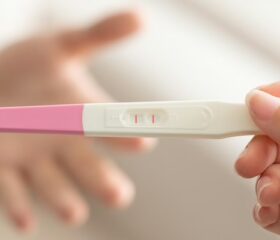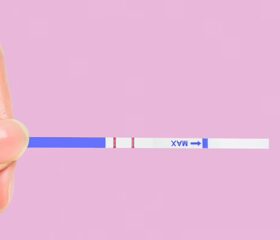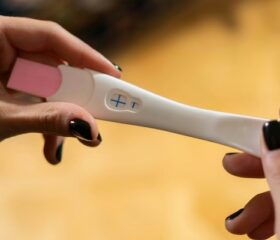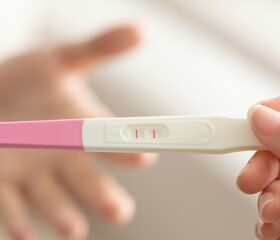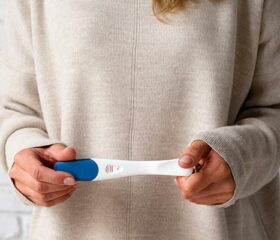What Does a Positive Ovulation Test Really Look Like? A Complete Guide
An ovulation test is a great tool for figuring out when you have the best chances of getting pregnant. But what exactly does a positive result look like?

- How do ovulation tests work?
- What does a positive ovulation test result look like?
- When should you start using ovulation tests each month?
- What to do after you get a positive result on your ovulation test
- Does a positive ovulation test always mean you’ll ovulate?
- What if you never see a positive ovulation test result?
- How much do ovulation tests cost?
- Final thoughts
If you’re trying to get pregnant, timing sex is essential. Many women use ovulation test strips, or ovulation predictor kits (OPKs), to identify their fertile windows.
But once you have that test in hand, you need to know what you’re looking for.
From faint lines to digital symbols, we’ll help you figure out what a positive result might look like for you and what you should do when you finally get one.
How do ovulation tests work?
Most ovulation tests look for a particular hormone in your urine: luteinizing hormone (LH).
Right before ovulation (when one of your ovaries releases an egg for fertilization), your levels of LH begin to rise, which triggers the release of the egg. This LH surge is what ovulation tests are looking for, and you’ll probably ovulate within 36 hours of it.
To use an ovulation test (digital or paper-based), simply pee on the test strip (preferably first thing in the morning, as your urine tends to be more concentrated then), and wait for the results to display.
What to know about saliva ovulation testing
With saliva-based ovulation testing, you’ll put a sample of your saliva on a glass slide and use a microscope to detect changes caused by your rising estrogen levels around the time you ovulate.
The idea is that when the saliva dries on a slide, it may crystallize into distinct, fern-like patterns, which suggests that you’re ovulating. If you’re not in your fertile window, the dried saliva will look like shapeless dots or lumps. 1
However, saliva-based ovulation testing isn’t very reliable; not all women get these fern-like patterns in their saliva, and even if you do, it might not coincide with your actual day of ovulation.
Moreover, other factors like smoking tobacco (which you should be avoiding if you’re trying to conceive), eating beforehand, or how you put your saliva on the slide can affect your results. 1 There’s no harm in trying this method, but don’t put too much stock in the results. 2
What does a positive ovulation test result look like?
There are three types of at-home ovulation tests. They display positive results in different ways:
- Paper-based ovulation test strips: These tests usually have two lines: a control line and a testing line. If you get a positive result, the testing line will be darker than the control line. Once your ovulation is over, you’ll either see a faint testing line or no line at all.
- Digital ovulation tests: If you’re ovulating, you’ll usually see “yes” displayed, or a clear symbol like a smiley face. If you haven’t entered your LH surge yet, your test will display “no” or an empty circle.
- Salivary ferning tests: As mentioned, if you’re ovulating, your saliva may form fern-like patterns as it dries on the glass slide.
When should you start using ovulation tests each month?
Don’t overdo it with ovulation tests. You should wait to start testing until you’re a few days away from ovulating.
If you have a regular 28-day cycle, you’ll usually ovulate around day 14, meaning you should start testing on day 11. If your cycle tends to be shorter or longer, adjust accordingly.
If you’re trying to track ovulation with irregular menstrual cycles, you may need to test more frequently to get a better idea of when you’re approaching ovulation.
How to test for ovulation accurately
To get the most accurate results from your ovulation test, try to: 3
- Test at the same time each day: Test first thing in the morning and use your first pee, as the LH in your urine tends to be more concentrated then.
- Limit your fluid intake: Don’t drink large amounts of liquids for about four hours before testing. Over-hydrating can dilute your urine and make it harder for the test to detect the LH surge.
- Read the results promptly: Check the results within the timeframe specified in the instructions, usually around 5–10 minutes. Faint lines can sometimes appear after the designated time, which can be misleading.
What to do after you get a positive result on your ovulation test
When you see that positive result on your ovulation test, the next step—as you probably already know—is to have sex.
Your chances of getting pregnant are much higher after seeing a positive ovulation test, so you can use this to time when to have sex.
Generally, your most fertile days are:
- The five days before you ovulate
- The day of ovulation
- The day after ovulation
Since sperm can survive in your reproductive tract for five days, it’s worth having sex multiple times in the five days leading up to ovulation. 4
Bear in mind that your egg is only viable for 12 to 24 hours after ovulation. 5 If you have sex more than a day after ovulating, you’ll be very unlikely to conceive from it.
Does a positive ovulation test always mean you’ll ovulate?
While ovulation tests are about 90% accurate at detecting an LH surge when used correctly, they don’t actually confirm you’re going to ovulate. 6
A positive ovulation test result simply demonstrates that you have high levels of LH in your urine.
Although that does often mean you’ll ovulate soon, there are other reasons you could have elevated LH levels, such as:
- Medical conditions: Women with polycystic ovary syndrome (PCOS) often have consistently high baseline levels of LH. This can cause the ovulation test to show a “positive” or near-positive result on any given day, even when a true LH surge isn’t happening. 7 Although you can still track ovulation and get pregnant with PCOS, you’re best off getting extra help from your doctor.
- Perimenopause: When women transition to menopause, their LH levels become much higher, even though they won’t actually be ovulating. 8
- Fertility medications: Fertility drugs, such as Clomid, can sometimes elevate your LH levels and cause a false positive result on your ovulation test. Always consult your doctor about how your specific treatment plan might impact at-home testing. 9
Note that it’s rarely the case that an ovulation test is faulty. That can happen, but it’s far more likely that one of the scenarios above is giving you a false positive result.
If you’re dealing with any of these issues, you’ll need to speak to your doctor.
You may get a positive ovulation test result if you’re already pregnant
When you’re pregnant, your body produces the hormone human chorionic gonadotropin (hCG). Since LH and hCG are structurally similar, your ovulation test may mistake the hCG in your urine for LH. As a result, you may see a faint positive ovulation test if you’re pregnant. However, you should never use an ovulation test to determine whether you’re pregnant—stick to genuine pregnancy tests. 10
What if you never see a positive ovulation test result?
If you’ve been testing for a while and haven’t seen a clear positive result, don’t panic. Getting consistent negative results doesn’t necessarily mean you’re never ovulating.
You could get repeated negative results if:
- You aren’t timing your tests correctly: Your ovulation might be occurring earlier or later in your cycle than you expect. Menstrual cycles vary from woman to woman and even from month to month. Try starting your testing a few days earlier in your next cycle, or continue testing for longer than you initially planned.
- Your LH surge is shorter than average: Many women experience an LH surge that lasts for several days. However, this is highly variable, and if you’re testing relatively infrequently (once every few days), it’s possible you’re missing it. If you suspect this is the case, try testing at least once per day, and preferably twice (once in the late morning and again in the evening) as you get closer to your predicted ovulation day.
- You used the test incorrectly: Human error is one of the most common reasons for getting inaccurate results on ovulation tests. Make sure you always read your test’s instructions, and, as mentioned, use your first morning pee, when LH tends to be more concentrated in your urine.
When to speak to your doctor about consistent negative ovulation test results
If you have very irregular cycles or have gone two or more consecutive months without detecting an LH surge, it’s a good idea to schedule a conversation with your OB/GYN.
Outside of the medical issues that can cause problems with ovulation, you should also speak with your doctor if you’ve unsuccessfully been trying to conceive for over a year (or 6 months if you’re over 35).
How much do ovulation tests cost?
Ovulation tests vary in price, with paper-based urine tests being the most affordable option, usually costing around $10 for a pack of 25 strips.
Digital tests tend to be more expensive, and they’re usually sold in packs that’ll cover one cycle (around 7–20 tests), costing anywhere between $20 and $40 on average.
Don’t be surprised if more advanced digital kits cost more.
As for salivary ovulation tests, you’ll just need to make a one-time purchase of a microscope, which may cost between $25 and $40. One bonus of this kind of testing is that you can use it repeatedly, making this more cost-effective in the long run (although, as mentioned, salivary testing often yields more ambiguous results).
Final thoughts
Getting a positive result on your ovulation test is an important step for starting or growing your family. Still, you’ll need to keep testing to figure out what a positive result looks like for you. If you want added clarity, you can opt for a digital test to get a definitive “yes” or “no” answer.
Of course, getting a positive ovulation test is just one part of successfully getting pregnant. You’ll also need to prepare your body for pregnancy by making healthy lifestyle choices, timing sex correctly, and getting help from your doctor if and when you need it.
With any luck, you’ll soon be seeing a positive pregnancy test, too!
Article Sources
- U.S. Food and Drug Administration. "Ovulation (Saliva Test)" Retrieved September 17, 2025.
- Fertility and Sterility. "Efficacy of methods for determining ovulation in a natural family planning program" Retrieved September 17, 2025.
- American Pregnancy Association. "How to Use Ovulation Kits & Fertility Monitors" Retrieved September 17, 2025.
- American College of Obstetricians and Gynecologists. "Trying to Get Pregnant? Here’s When to Have Sex." Retrieved September 17, 2025.
- Cleveland Clinic. "Ovulation" Retrieved September 17, 2025.
- U.S. Food and Drug Administration. "Ovulation (Urine Test)" Retrieved September 17, 2025.
- Frontiers in Medicine. "Role of luteinizing hormone elevation in outcomes of ovulation induction with letrozole for polycystic ovary syndrome" Retrieved September 17, 2025.
- Cleveland Clinic. "Luteinizing Hormone" Retrieved September 17, 2025.
- UCSF Health. "Ovulation home test" Retrieved September 17, 2025.
- Women In Balance. "Will an Ovulation Test Be Positive If Pregnant?" Retrieved September 17, 2025.

